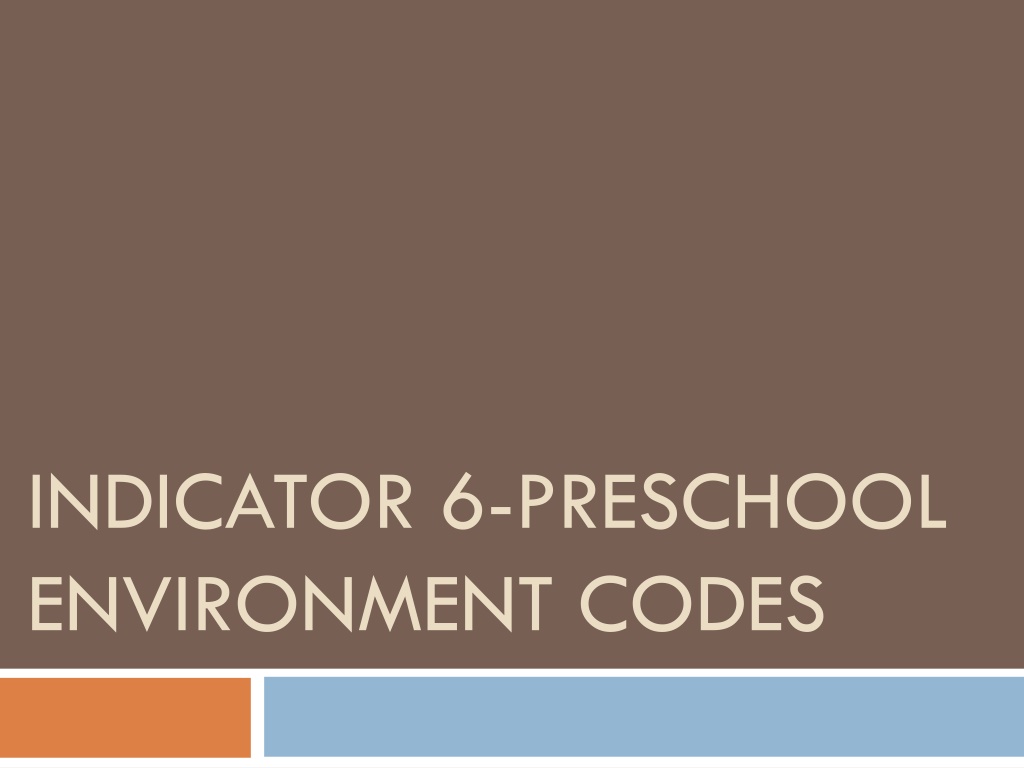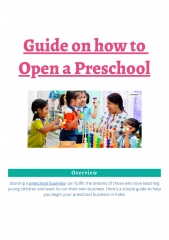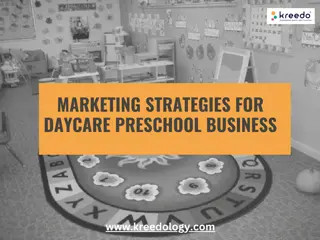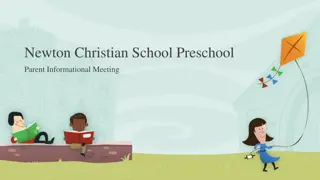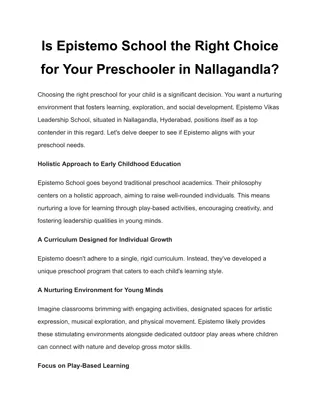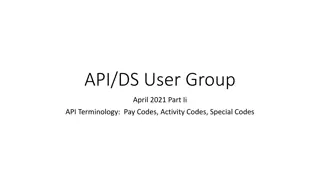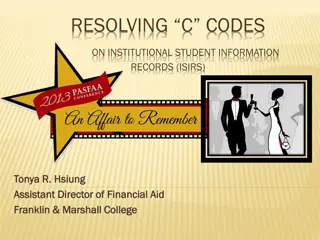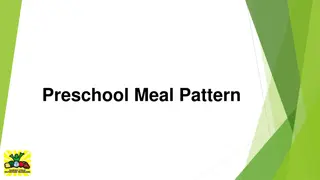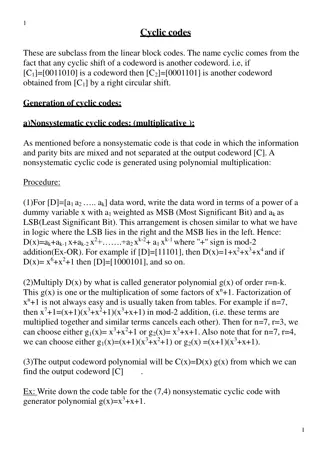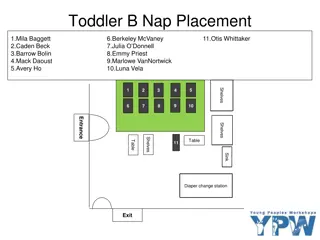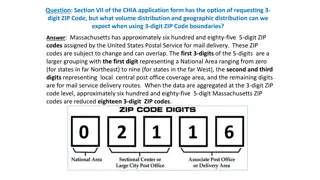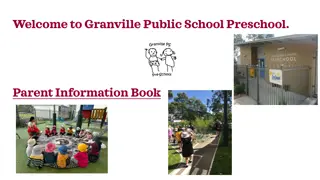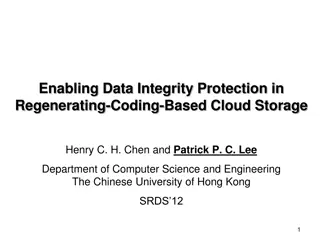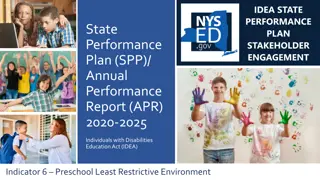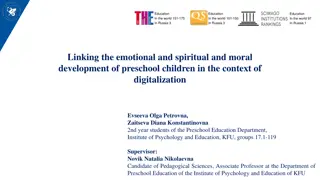Understanding Indicator 6: Preschool Environment Codes
This information provides insights into Indicator 6, focusing on the percentage of children ages 3 through 5 with Individualized Education Programs (IEPs) attending regular early childhood programs versus separate special education classes. It delves into the definitions of regular early childhood programs, different types of programs, and scenarios where children receive special education services within these programs.
Download Presentation

Please find below an Image/Link to download the presentation.
The content on the website is provided AS IS for your information and personal use only. It may not be sold, licensed, or shared on other websites without obtaining consent from the author. Download presentation by click this link. If you encounter any issues during the download, it is possible that the publisher has removed the file from their server.
E N D
Presentation Transcript
INDICATOR 6-PRESCHOOL ENVIRONMENT CODES
Indicator 6-Preschool Environment Codes Percentage of children ages 3 through 5 with IEPs attending a: A. Regular early childhood program and receiving the majority of special education and related services in the regular early childhood program; and B. Separate special education class; separate school, or residential facility. (20 U.S.C.1416(a)(3)(A))
Regular Early Childhood Program The majority of children (50% or more) are typically developing children or children without IEPs. It s not a room, a place, or the title of the school. It s the children.
Regular Early Childhood Programs District Pre-K programs; Private Pre-K or K (including faith based or parochial schools); Childcare or Child Development Centers (commercial, such as Kindercare, La Petite, etc. or home based childcare); HeadStart; Playgroups (health department, Mothers of Preschoolers, etc.)
A1 Regular EC Program >=10 hrs/wk (majority sped/related svcs in reg EC) Child attends a regular early childhood program at least 10 hours per week and receives the majority of special education and related services hours in the regular early childhood program. Parentally placed or IEP team placement.
A1~What does it look like? The child receives the majority of special education and related services, at least 50% or more in the regular early childhood program. A preschool program that is 2.5 hours a day/5 days a week AND the majority of services are integrated in the program.
A2 Regular EC Program >=10 hrs./wk (majority sped/related svcs in other location) Child attends a regular early childhood program at least 10 hours per week and receives the majority of special education and related services in some other location.
A2~ What does it look like? Child attends a regular early childhood program. The majority of special education and related services occurs in another location. The child receives 30 minutes a day of special education in the resource room and 60 minutes a week of speech in the speech therapy room.
B1 Regular EC program <10 hrs/wk (majority sped/related svcs in reg. EC program) Child attends a regular early childhood program less than 10 hours a week and receives the majority of special education and related hours in the regular early childhood program.
B1~What does it look like? A part-time structured Mother s Day Out program 2-3 days a week for 2 hours. Library story time once a week for 1.5 hours. Playgroups at the Health Dept. on T/Th for 1.5 hours. Special education and related services are integrated into these settings.
B2 Regular EC program <10hrs/wk (majority sped/related svcs in other location. Child attends a regular early childhood program less than 10 hours per week and receives the majority of special education and related services hours in some other location.
B2~What does it look like? A part-time structured Mother s Day Out program 2-3 days a week for 2 hours. Library story time 1time a week for 1.5 hours. Playgroups at the Health Dept. on T/Th for 1.5 hours. Special education and related services happen at the provider location.
C1: Separate Class Child attends a special education early childhood program in a special education class. A program that includes less than 50% non-disabled or typically developing children. Ex: more than half of the children in the program have disabilities or IEPs. Again, not the classroom, but the children.
C1: Separate Class Special education early childhood programs include, but are not limited to: Special Education Classrooms in regular school buildings (Developmentally Delayed preschool classroom in elementary school). Childcare facilities for children with disabilities. There may be some regular early childhood program time.
C2: Separate School Child attends a special education early childhood in a separate school.
C2~What does it look like? Child receives special education and related services at a separate school. Where they attend during the day. Special Care Little Lighthouse Day attendance at Oklahoma School for the Deaf or Oklahoma School for the Blind
C3: Residential Facility Child attends a special education early childhood program in a residential facility.
C3~What does it look like? Child is in a residential placement. A residential placement is where the child sleeps at night. Shadow Mountain JD McCarty Center St. Anthony s behavioral health Camelot
D1: Home Child attends neither a regular early childhood program nor a special education program and receives the majority of special education and related services at home or caregiver s residence (babysitter or Grandma).
D1-What does it look like? Child is found eligible under the category of Developmentally Delayed, but requires only language therapy. The Speech- Language Pathologist goes into the child s home (or caregiver s home) and provides services.
D2: Service Provider Location Child attends neither a regular early childhood program nor a special education program and receives the majority of special education and related services hours at the service provider location or some other location not in any other category.
D2~What does it look like? Child requires only some behavioral interventions, but does not attend a preschool program. Parent transports the child to the school to receive behavioral intervention and training.
Location SPED services Code Child attends a regular early childhood program at least 10 hours a week . And receives the majority of special education and related services in the regular early childhood program A1 And receives the majority of special education and related services in some other location. A2 Child attends a regular early childhood program less than 10 hours a week... And receives the majority of special education and related services in the general education early childhood program B1 And receives the majority of special education and related services in some other location. B2 Child attends a special education early childhood program In a separate special education class. C1 In a separate school. C2 In a residential facility. C3 Child does not attend a preschool program (none of the above) And receives the majority of special education and related services at home. D1 And receives the majority of special education and related services at the service provider location or some other location not in any other category. D2
Thoughts A child may change from one placement to another during the school year. If the majority of your early childhood codes are C and D codes, you may want to explore options. Don t think automatically or in a prescripted way.
Thoughts Five year olds in Kindergarten Remember: Environment codes are determined by the age of child not grade. For Oct. 1 Child Count, all 5 year olds will be reported with Indicator 6 preschool environment codes, 6 year olds will be coded use Indicator 5 LRE codes.
Example 1 Alexis is a 3 year old student with Down Syndrome. She receives all her instruction in a Preschool classroom for children with Developmental Delays. The DD class is full time. She also receives speech, OT, and PT. What is Alexis s program code?
Example 2 Landon is a 4 year old who attends a general education preschool classroom full day. The special education teacher pulls him into her resource room for 30 minutes a day, and the speech therapist pulls him to her room 2 times a week for 30 minutes. What is Landon s program code?
Example 3 Henry is a three year old who receives speech only services. The SLP is itinerant, serving children in daycares, Head Starts, and in their homes. She sees Henry three times a week in his home to train the family on how to increase Henry s language skills. What is Henry s program code?
Example 4 Ella is a 4 year old who attends a general education preschool class for half day. The speech therapist goes into the general education classroom to conduct a work center for all students a total of 30 minutes a week. What is Ella s program code?
